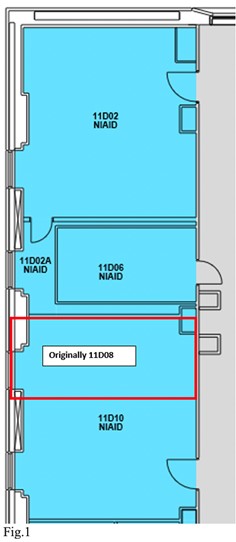What does it mean when the Division of Radiation Safety (DRS) says we have 575 posted labs at NIH? Just what defines a "lab" anyway? If you're an Authorized User and you've ever been confused about the list of labs assigned to you on your monthly DRS report, this explanation should help.
Over the past 30 years, architects, engineers, facility managers and researchers have revised the design of a typical research lab. An increasing number of institutions, including NIH, are creating "open" labs to support team-based work. The "open" lab concept is significantly different from the "closed" lab of the past, which was based on accommodating the individual Principle Investigator. This "closed" lab is what NIH used for lab design from 1938 through the 1990s and is still common in older buildings at NIH.
The NIH Design Requirements Manual defines a standard open-lab module as 11'x33,' slightly larger than the 230 ft2 used in a typical "closed" lab design. DRS uses the standard lab space definition when posting labs for radioactive materials use. This means that what you call "one lab" (especially an open concept lab) may be two, or three, or more, labs by the DRS definition of numbering. Why not just go by the ORF room numbering outside each lab entry? DRS requires a specified, consistent square footage of space to equal "one lab", which assures that the 10 smear samples collected during a radiation survey are adequate to appropriately cover the lab area footprint. Do you have, say, a triple module lab? We will consider this space to be three separate labs. If designated by ORF as one room number, we'll name the labs A, B and C.
The numbering system DRS uses to identify each lab may or may not match to what ORF has named it (the hallway placard), or what other ORS Divisions may name it, or what you yourself may refer to it as. From a historical perspective, DRS needs to retain the lab designation to what the ORF designation was when the lab was originally posted, which could be decades ago. This is because there are many other historical records linked to a lab on the DRS database - like radioactive materials delivered, radioactive waste removed, compliance surveys performed, and any counting equipment that DRS tracks.
Even after a "closed" lab design is renovated to an open concept design, DRS typically maintains the original room numbering designation, because all the historic records are still linked to the original lab designation. For example, building 10/11D08 is currently an active lab with records dating to 1991. DRS will continue to identify this room as 11D08 even though the space has since been renovated to an "open" lab design and designated by entry signage as 11D10 (Fig.1).


However, if a building has gone through a full (formal) radiological decommissioning, we can close out all historical recordkeeping and wipe the slate clean. DRS is no longer required to track historical radioactive material usage in a decommissioned building and can adopt the numbering system of newly renovated space.
So, there you have it: your triple module "open" lab space will count as three labs by DRS database metrics, with each one designated by a unique room number for DRS tracking. If radioactive materials are used across all three modules, you'll be sent copies of three lab surveys for each round of compliance monitoring, note three labs listed under your Authorized User record in the DRS AU Portal, and (perhaps) be confounded by the DRS contractor asking for access to three lab spaces when tracking down survey instruments to calibrate. Of course, if radioactivity is only used in one module, only that one "lab" will be posted and tracked by DRS.
DRS lab numbering can get confusing and nearly always disagrees with official ORF room numbering and door signage. However, if you ever need clarification on your posted lab designations, please call on your health physicist at 301-496-5774 to help explain which room number matches with which lab space.
